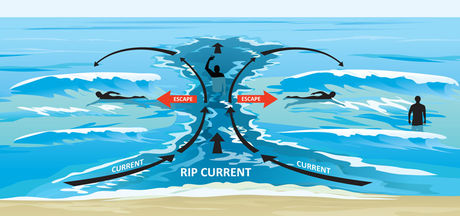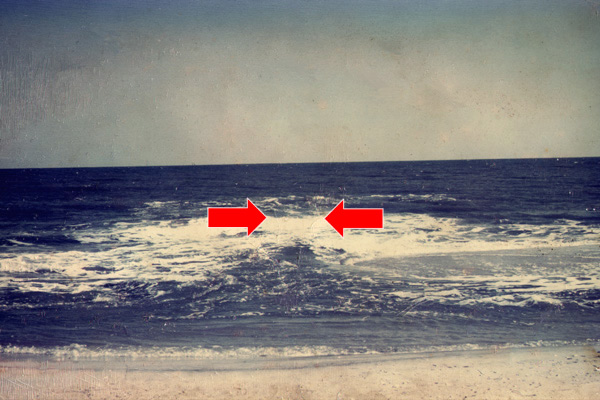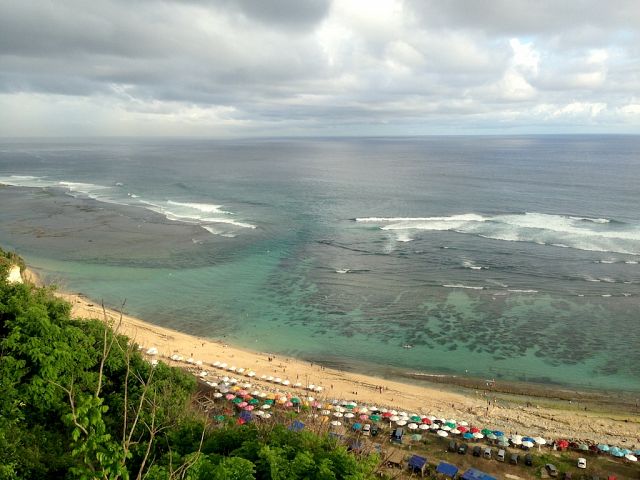Ocean safety rules, river flow

Many people think that the most dangerous thing in the ocean for swimmers is big waves. However, this is not the case. When a big wave crashes, it creates strong white foam that pushes you toward the shore. In other words, the waves themselves won't let you get close to them; they will constantly push you back to the shore. Yes, this may involve somersaults, getting scraped on the sand, and other forms of fun, but there is no significant danger in this.
Now, let's consider the main source of danger when swimming in the ocean - rip currents.
The essence of a rip current is that in certain areas near the shore, there is a flow directed out into the ocean. It's not wide (up to 20-40 meters) or long (up to 100-200 meters), but it's often very strong. It can be challenging to swim against it, even on a surfboard.
The reason for its formation is that in these areas, the water is deeper, and as the waves come crashing in, the water tends to flow back into the ocean. This flow can potentially drag you out into the ocean.

Usually, untrained individuals don't notice such currents and venture to swim right there (because there are no waves in these currents, it seems safe). Here's what typically happens next: the current carries the person out into the ocean. After a few minutes, the person realizes they are much farther from the shore than they thought. They get scared, turn around, and start swimming frantically back towards the shore – against the current, which is futile because the current is still stronger, and their strength is running out.
It's understandable that an untrained person's strength diminishes within minutes, and fear and panic intensify as they keep paddling with all their might while the shore keeps receding. They are focused on the shore, and that's why the oncoming waves (even small ones) continuously engulf them, disrupting their breathing and increasing their fear. After a while, their strength gives out, and they succumb to another breaking wave and start to drown.
Moreover, shouting is futile because the noise from the waves on the shore makes it nearly impossible to hear anything. Only trained lifeguards might notice someone drowning, but ordinary beachgoers are unlikely to recognize the signs or understand that someone is drowning.
Another dangerous aspect is that rip currents are highly dependent on the current wave size and water level. This means you could swim at a particular beach a couple of times without any issues. However, on another day, during low tide or when there are strong waves, a powerful rip current can form unexpectedly, and you may get caught in it without realizing that this once-safe spot has become dangerous.

For example, this is what a powerful channel looks like on the left side of Pandawa Beach:

What should you do to get ashore from a rip current?
The most crucial thing is not to panic. It's challenging, but it's what will save your life.
Next, assess the situation. Understand which direction the current is carrying you, at what speed, whether there are dangerously large waves, if there's anyone on the beach to signal to, or if there are people in the water, such as surfers, whom you can call for help.
Then, try to escape the current by swimming parallel to the shore. Do it calmly, methodically, and breathe steadily as you swim along the shore for a few minutes. Keep an eye on the waves! Dive under them when necessary. Make sure you're making progress relative to the shore. Use a landmark on the shore as a reference point.
Afterward, reevaluate the situation. Have you escaped the current? If you swam to the right but haven't made progress, try swimming to the left of the channel.
After some time, assess the situation again. If you're no longer being carried by the current, calmly swim toward the shore, trying to use the waves to help push you.
If there are surfers nearby, then don't hesitate to ask them for help! Wave them!
Rules that will allow the average vacationer to swim safely in the ocean:
1. Most importantly, assess your abilities.
If you are not a professional swimmer, if you do not have specific experience swimming in waves and dealing with rip currents, then you should unequivocally choose only prepared beaches with safe areas! Do not swim on wild beaches - there is no one to ask for help!
If you decide to swim, swim along the shore!
Do not swim while intoxicated!
Avoid swimming after dark!
Do not swim alone!
If you have no experience swimming in the ocean, it's better not to enter the ocean at all!
2. Assess the ocean beforehand.
Before going for a swim, check the wave conditions, see if there are lifeguards on duty, look for flags indicating where and what kind of swimming areas are designated, observe if there are other people in the water, and note the presence of surfers (avoid swimming near them, as they may accidentally collide with you).
According to international safety standards, safe swimming zones are marked with yellow-red flags. You can swim between these yellow-red flags as these areas are monitored by lifeguards.

Red flags indicate areas where swimming is prohibited!
If you're unsure about where it's safe to swim, don't hesitate to ask the lifeguards for guidance!

3. Keep an eye on what's happening while swimming!
When you're in the water, watch the shore, and make sure you're not being carried away by the current into the ocean. Swim along the coastline, and don't venture too far into the ocean!
You can add one right now!